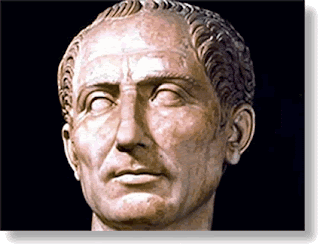Caesar himself progressed within the Roman political system, becoming in succession quaestor (69), aedile (65) and praetor (62). In 61-60 BC he served as governor of the Roman province of Spain. Back in Rome in 60, Caesar made a pact with Pompey and Crassus, who helped him to get elected as consul for 59 BC. The following year he was appointed governor of Roman Gaul where he stayed for eight years, adding the whole of modern France and Belgium to the Roman Empire, and making Rome safe from the possibility of Gallic invasions. He made two expeditions to Britain, in 55 BC and 54 BC.
Caesar spent some time in Egypt. He helped put queen Cleopatra back on the throne as Egypt’s ruler. Cleopatra’s brother had removed her from power. Next, Caesar marched east, to crush a rebellion in what is now Turkey. Caesar was now master of Rome and made himself consul and dictator. He used his power to carry out much-needed reform, relieving debt, enlarging the senate, building the Forum Iulium and revising the calendar. Dictatorship was always regarded a temporary position but in 44 BC, Caesar took it for life. His success and ambition alienated strongly republican senators. Many Romans admired him, but others felt uneasy that he had so much power. Some senators felt the Roman Senate should have more power. These senators stabbed Caesar to death on March 15 in 44 bc. March 15 was known as the Ides of March in the Roman calendar. When people say, “Beware the Ides of March,” they are referring to the plot to kill Caesar and the possibility of unknown danger lurking nearby.


No comments:
Post a Comment